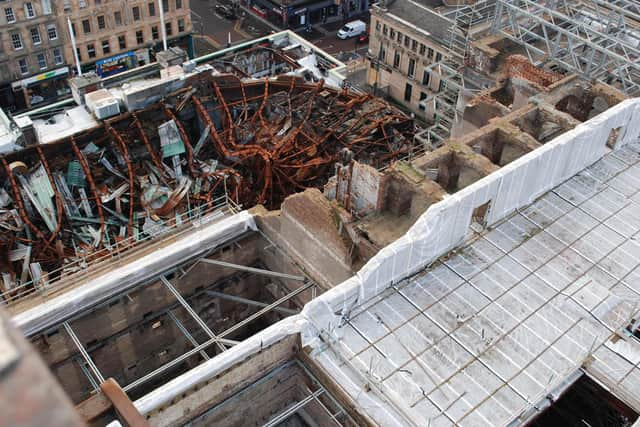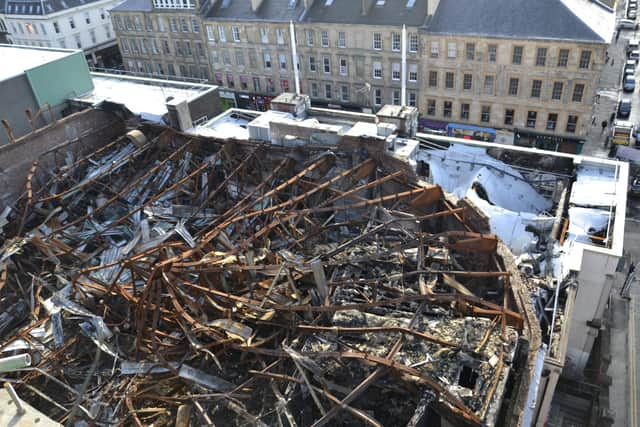No cause found for Glasgow Art School fire after three-year investigation
and live on Freeview channel 276
The Scottish Fire and Rescue Service has ruled that the cause of the “catastrophic” incident at the Mackintosh Building could not be determined due to extensive damage caused and a lack of evidence.
Almost all combustible materials in the building were destroyed in the fire, leaving only walls, bare stone and brickwork.
Lessons for the future
Advertisement
Hide AdAdvertisement
Hide AdHowever the official inquiry into the blaze has recommended that lessons are for future major construction projects, with management teams urged to “fully consider the risk of fire” and insisted on fire safety training for all on-site staff.


The official investigation report stated that the Mackintosh Building was in a vulnerable condition and at higher risk of fire due to the ongoing restoration work, and that the ducts that were part of the ventilation system probably helped the fire spread as “the well-ventilated ducts most likely served to provide a chimney effect, entraining an endless supply of fresh air to the fire as it developed and spread across the entire building”.
Glasgow School of Art chiefs, who last year announced they would be exploring how to carry out a “faithful reinstatement” of the Mackintosh Building, pledged to carry out a “lessons learned exercise” on all aspects of the restoration to inform future projects.
What did the investigation find?
Hundreds of tonnes of rubble were searched for months in the aftermath of the fire on 15 June 2018 at the site where the Charles Rennie Mackintosh-designed building was being restored following a previous blaze in May 2014.
Advertisement
Hide AdAdvertisement
Hide AdThe possibility of wilful fire-raising, faulty electrical appliances or systems, and accidental ignition were all explored by the team who investigated the 2018 fire. The investigation found that wilful fire-raising and electrical failure could not be fully discounted, while accidental ignition by something like a cigarette could not be fully ruled out.


The report states: “Despite an unprecedented and extended investigative process, sufficient evidence to support any credible origin and cause hypothesis has not been recovered from the scene or evidenced in witness testimonies or eyewitness accounts.
“Therefore, the origin and cause of the fire incident has been recorded as ‘undetermined.’
“Should further information be presented that may alter this conclusion, this will be considered, and the findings contained within this fire investigation report may be subject to a comprehensive review.”
‘Complex and protracted’
Advertisement
Hide AdAdvertisement
Hide AdRoss Haggart, deputy chief officer at the SFRS, said: “Our investigation has been a deeply complex and protracted process.
“Due to the nature of the ongoing restoration and construction works combined with other factors such as the air supply into the building, the fire was unfortunately able to take hold, spread and ultimately cause catastrophic damage.
“This presented a number of challenges to our investigation, namely working within a structurally dangerous site to physically examine hundreds of tonnes of debris which was up to four metres in height and heavily compacted.
“We scrutinised every aspect of this fire to ensure our investigation was as robust and thorough as possible.
Advertisement
Hide AdAdvertisement
Hide Ad“Unfortunately, almost everything within the building was severely damaged or consumed in the fire and that included any potential items of evidence that could have provided those answers.”
What did the art school say?
In a joint statement from Glasgow School of Art, director Penny Macbeth and interim chair Kristen Bennie said: “We would like to thank the Scottish Fire and Rescue Service for their meticulous approach to this incredibly complex investigation, and for their steadfast commitment to establishing the facts and the cause of the 2018 fire.
“It has been a very difficult time for the city, and in particular our closest neighbours, for students, staff and the wider heritage sector all of whom have been impacted in myriad ways by both Mackintosh Building fires.
“While the report is detailed and comprehensive, we share the frustration that many will feel that the exact cause of the fire has not been identified.
Advertisement
Hide AdAdvertisement
Hide Ad“Taking time to study and consider the report thoroughly, in particular the recommendations, we will now undertake and share a lessons learned exercise on all aspects of the restoration to inform future construction projects.
“The investigation report is an important milestone allowing us to progress the Mackintosh Project as outlined last October.
“We are committed to the faithful reinstatement of the Mackintosh Building within the practical constraints of the regulatory environment, as an integral part of the GSA, as a catalyst and key driver for the social and economic revival of Garnethill and Glasgow and as an exemplar of sustainability for heritage buildings.”
Comment Guidelines
National World encourages reader discussion on our stories. User feedback, insights and back-and-forth exchanges add a rich layer of context to reporting. Please review our Community Guidelines before commenting.
